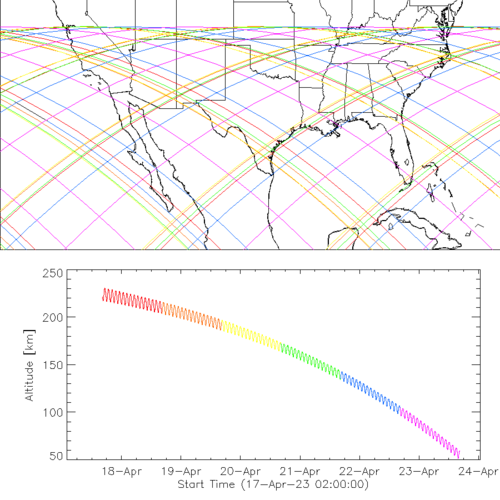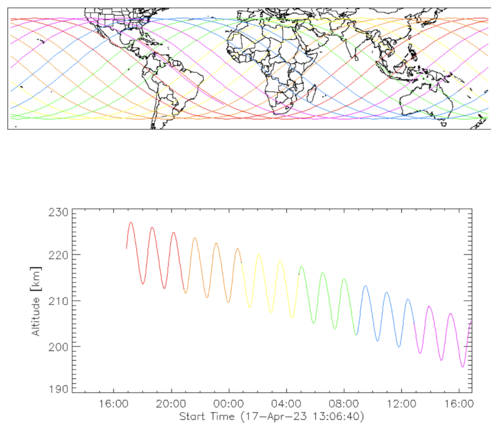RHESSI's Re-entry
From RHESSI Wiki
| Line 14: | Line 14: | ||
Our inspiration for these Nuggets, the | Our inspiration for these Nuggets, the | ||
[https://en.wikipedia.org/wiki/Reuven_Ramaty_High_Energy_Solar_Spectroscopic_Imager RHESSI] | [https://en.wikipedia.org/wiki/Reuven_Ramaty_High_Energy_Solar_Spectroscopic_Imager RHESSI] | ||
| + | hard X-ray and γ-ray observatory. | ||
went into orbit February 5, 2002, and observed the Sun successfully for | went into orbit February 5, 2002, and observed the Sun successfully for | ||
many years. | many years. | ||
| - | + | Many earlier Nuggets describe its achievements, and in fact data analyses continue to the present | |
| + | (for example, the recent [https://sprg.ssl.berkeley.edu/~tohban/wiki/index.php/Particle_Acceleration_in_Two_Coronal_Jets Nugget No. 445]) | ||
| + | Such a re-entry is the final fate of any spacecraft in | ||
[https://en.wikipedia.org/wiki/Low_Earth_orbit low Earth orbit] | [https://en.wikipedia.org/wiki/Low_Earth_orbit low Earth orbit] | ||
| - | + | and the delicate and precise machinery of RHESSI will become a colorful fireball in its last moments. | |
== Orbit predictions == | == Orbit predictions == | ||
| Line 28: | Line 31: | ||
fluctuations in the drag force from Earth's upper atmosphere. | fluctuations in the drag force from Earth's upper atmosphere. | ||
| - | [[File:447f2.png| | + | [[File:447f2.png|500px|thumb|center|<b>Figure 1:</b> <i> |
Upper, a map of satellite tracks for the whole Earth, in a Mercator projection. | Upper, a map of satellite tracks for the whole Earth, in a Mercator projection. | ||
Lower, color-coded time-series plot showing the predicted orbital altitudes. | Lower, color-coded time-series plot showing the predicted orbital altitudes. | ||
| Line 48: | Line 51: | ||
in Berkeley, California. | in Berkeley, California. | ||
| - | [[File:447f1.png| | + | [[File:447f1.png|500px|thumb|center|<b>Figure 2:</b> <i> |
| - | + | Similar to Figure 1, except for the continental US. | |
</i> | </i> | ||
]] | ]] | ||
| Line 69: | Line 72: | ||
[https://en.wikipedia.org/wiki/Atomic_emission_spectroscopy#Flame_emission_spectroscopy flame spectra] | [https://en.wikipedia.org/wiki/Atomic_emission_spectroscopy#Flame_emission_spectroscopy flame spectra] | ||
colors, and germanium is light blue. | colors, and germanium is light blue. | ||
| - | As a speculation a lucky observer might see the last moments of the RHESSI | + | As a wild speculation, a lucky observer might see the last moments of the RHESSI detectors this way. |
| - | detectors this way. | + | This is very speculative, of course, as is the further thought that the tungsten |
| - | This is very speculative, of course, as is the | + | grids (green flame spectrum), being massive, dense, and highly refractive, may even survive |
| - | grids (green), being massive, dense, and highly refractive, may even survive | + | re-entry! |
| - | re-entry | + | Do not stand underneath.... |
Revision as of 16:08, 15 April 2023
| Nugget | |
|---|---|
| Number: | 447 |
| 1st Author: | Pascal SAINT-HILAIRE, |
| 2nd Author: | Hugh HUDSON |
| Published: | April 17, 2023 |
| Next Nugget: | |
| Previous Nugget: | A Glasgow geomagnetic observation of a solar flare |
| List all | |
Introduction
Our inspiration for these Nuggets, the RHESSI hard X-ray and γ-ray observatory. went into orbit February 5, 2002, and observed the Sun successfully for many years. Many earlier Nuggets describe its achievements, and in fact data analyses continue to the present (for example, the recent Nugget No. 445) Such a re-entry is the final fate of any spacecraft in low Earth orbit and the delicate and precise machinery of RHESSI will become a colorful fireball in its last moments.
Orbit predictions
Figure 1 shows the predicted altitude via estimates made on Friday, April 15. The actual re-entry forecast time for this epoch was 20 April (Thursday) 00:05 +- 30 hours, but this number will improve as we get closer to the end. The final stages of re-entry are uncertain in detail because of unpredictable fluctuations in the drag force from Earth's upper atmosphere.
Observability
The re-entry will suddenly interrupt RHESSI's final orbit. The imprecision of the exact time means that it could happen anywhere along the predicted orbital path, and the conservation of momentum means that the resulting fireball will trace out that path. Figure 2 shows some of the orbits, spaced approximately at 90-minute intervals and therefore about 23-degree spacings in longitude as the Earth rotates. One can see the that RHESSI's orbit was inclined to match the latitude of its ground station (at the [Space Sciences Lab] in Berkeley, California.
As with any re-entry, we expect that visual observations of the fireball will be possible for a very lucky observer. Ideally one would have clear skies, a dark night, and the great luck of having the just the right moment along the orbital track. Figure 3 shows the local area around Berkeley, where some RHESSI-lovers may be watching.
What will the observer see? Most elements have distinctive flame spectra colors, and germanium is light blue. As a wild speculation, a lucky observer might see the last moments of the RHESSI detectors this way. This is very speculative, of course, as is the further thought that the tungsten grids (green flame spectrum), being massive, dense, and highly refractive, may even survive re-entry! Do not stand underneath....
| RHESSI Nugget Date | 17 April 2023 + |
| RHESSI Nugget First Author | Pascal SAINT-HILAIRE, + |
| RHESSI Nugget Index | 447 + |
| RHESSI Nugget Second Author | Hugh HUDSON + |


